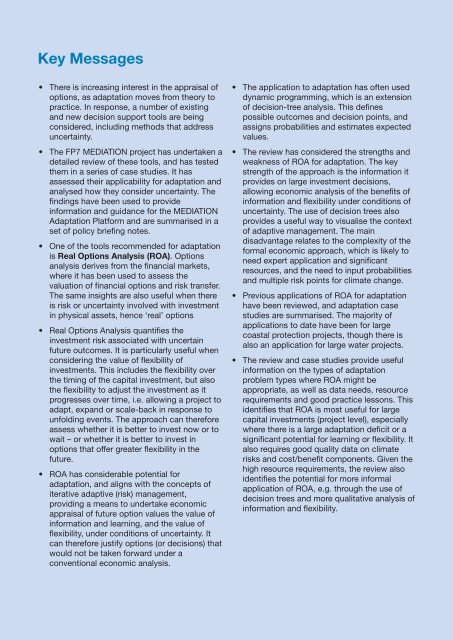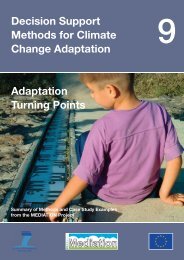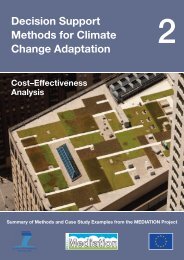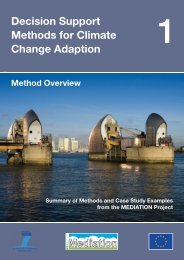Key Messages• There is <strong>in</strong>creas<strong>in</strong>g <strong>in</strong>terest <strong>in</strong> the appraisal ofoptions, as adaptation moves from theory topractice. In response, a number of exist<strong>in</strong>gand new decision support tools are be<strong>in</strong>gconsidered, <strong>in</strong>clud<strong>in</strong>g methods that addressuncerta<strong>in</strong>ty.• The FP7 MEDIATION project has undertaken adetailed review of these tools, and has testedthem <strong>in</strong> a series of case studies. It hasassessed their applicability for adaptation andanalysed how they consider uncerta<strong>in</strong>ty. Thef<strong>in</strong>d<strong>in</strong>gs have been used to provide<strong>in</strong>formation and guidance for the MEDIATIONAdaptation Platform and are summarised <strong>in</strong> aset of policy brief<strong>in</strong>g notes.• One of the tools recommended for adaptationis Real Options Analysis (ROA). Optionsanalysis derives from the f<strong>in</strong>ancial markets,where it has been used to assess thevaluation of f<strong>in</strong>ancial options and risk transfer.The same <strong>in</strong>sights are also useful when thereis risk or uncerta<strong>in</strong>ty <strong>in</strong>volved with <strong>in</strong>vestment<strong>in</strong> physical assets, hence ‘real’ options• Real Options Analysis quantifies the<strong>in</strong>vestment risk associated with uncerta<strong>in</strong>future outcomes. It is particularly useful whenconsider<strong>in</strong>g the value of flexibility of<strong>in</strong>vestments. This <strong>in</strong>cludes the flexibility overthe tim<strong>in</strong>g of the capital <strong>in</strong>vestment, but alsothe flexibility to adjust the <strong>in</strong>vestment as itprogresses over time, i.e. <strong>all</strong>ow<strong>in</strong>g a project toadapt, expand or scale-back <strong>in</strong> response tounfold<strong>in</strong>g events. The approach can thereforeassess whether it is better to <strong>in</strong>vest now or towait – or whether it is better to <strong>in</strong>vest <strong>in</strong>options that offer greater flexibility <strong>in</strong> thefuture.• ROA has considerable potential foradaptation, and aligns with the concepts ofiterative adaptive (risk) management,provid<strong>in</strong>g a means to undertake economicappraisal of future option values the value of<strong>in</strong>formation and learn<strong>in</strong>g, and the value offlexibility, under conditions of uncerta<strong>in</strong>ty. Itcan therefore justify options (or decisions) thatwould not be taken forward under aconventional economic analysis.• The application to adaptation has often useddynamic programm<strong>in</strong>g, which is an extensionof decision-tree analysis. This def<strong>in</strong>espossible outcomes and decision po<strong>in</strong>ts, andassigns probabilities and estimates expectedvalues.• The review has considered the strengths andweakness of ROA for adaptation. The keystrength of the approach is the <strong>in</strong>formation itprovides on large <strong>in</strong>vestment decisions,<strong>all</strong>ow<strong>in</strong>g economic analysis of the benefits of<strong>in</strong>formation and flexibility under conditions ofuncerta<strong>in</strong>ty. The use of decision trees alsoprovides a useful way to visualise the contextof adaptive management. The ma<strong>in</strong>disadvantage relates to the complexity of theformal economic approach, which is likely toneed expert application and significantresources, and the need to <strong>in</strong>put probabilitiesand multiple risk po<strong>in</strong>ts for climate change.• Previous applications of ROA for adaptationhave been reviewed, and adaptation casestudies are summarised. The majority ofapplications to date have been for largecoastal protection projects, though there isalso an application for large water projects.• The review and case studies provide useful<strong>in</strong>formation on the types of adaptationproblem types where ROA might beappropriate, as well as data needs, resourcerequirements and good practice lessons. Thisidentifies that ROA is most useful for largecapital <strong>in</strong>vestments (project level), especi<strong>all</strong>ywhere there is a large adaptation deficit or asignificant potential for learn<strong>in</strong>g or flexibility. Italso requires good quality data on climaterisks and cost/benefit components. Given thehigh resource requirements, the review alsoidentifies the potential for more <strong>in</strong>formalapplication of ROA, e.g. through the use ofdecision trees and more qualitative analysis of<strong>in</strong>formation and flexibility.
Real Options AnalysisIntroductionThere is <strong>in</strong>creas<strong>in</strong>g policy <strong>in</strong>terest <strong>in</strong> the appraisalof options, as adaptation moves from theory topractice. At the same time, it is recognised thatthe appraisal of climate change adaptation<strong>in</strong>volves a number of major ch<strong>all</strong>enges,particularly the consideration of uncerta<strong>in</strong>ty. Inresponse, a number of exist<strong>in</strong>g and new decisionsupport tools are be<strong>in</strong>g considered for adaptation.The European Commission FP7 fundedMEDIATION project (Methodology for EffectiveDecision-mak<strong>in</strong>g on Impacts and AdaptaTION) islook<strong>in</strong>g at adaptation decision support tools, <strong>in</strong>l<strong>in</strong>e with its objectives to advance the analysis ofimpacts, vulnerability and adaptation, and topromote knowledge shar<strong>in</strong>g through aMEDIATION Adaptation Platform (http://www.mediation-project.eu/platform/). To complementthe <strong>in</strong>formation on the Platform, a series of <strong>Policy</strong><strong>Brief<strong>in</strong>g</strong> <strong>Notes</strong> have been produced on DecisionSupport Methods for Climate Change Adaptation.An overview of <strong>all</strong> the decision support toolsreviewed is provided <strong>in</strong> <strong>Policy</strong> <strong>Brief<strong>in</strong>g</strong> Note 1:Method Overview, which summarises eachmethod, discusses the potential relevance foradaptation and provides guidance on theirpotential applicability. The methods considered<strong>in</strong>clude exist<strong>in</strong>g appraisal tools (cost-benefitanalysis, cost-effectiveness analysis and multicriteriaanalysis), as well as techniques that morefully address uncerta<strong>in</strong>ty (real options analysis,robust decision mak<strong>in</strong>g, portfolio analysis anditerative risk (adaptive) management). It also<strong>in</strong>cludes complementary tools that can assist <strong>in</strong>adaptation assessment, <strong>in</strong>clud<strong>in</strong>g analyticalhierarchic processes, social network analysisand adaptation turn<strong>in</strong>g po<strong>in</strong>ts. Additional<strong>in</strong>formation on each method is presented <strong>in</strong> aseparate <strong>Policy</strong> <strong>Brief<strong>in</strong>g</strong> <strong>Notes</strong> (2 – 10).This <strong>Policy</strong> Brief (Note 3) provides a summary ofreal options analysis. It provides a briefsynthesis of the approach, its strengths andweaknesses, the relevance for adaptation, how itconsiders uncerta<strong>in</strong>ty, and presents case studyexamples. It is stressed that this note onlyprovides an overview: more detailed <strong>in</strong>formationis available <strong>in</strong> MEDIATION deliverables, andsources and l<strong>in</strong>ks on the MEDIATION AdaptationPlatform.Description of the MethodThe concepts of real options analysis lieorig<strong>in</strong><strong>all</strong>y <strong>in</strong> the f<strong>in</strong>ancial markets. A f<strong>in</strong>ancialoption gives the <strong>in</strong>vestor the right, but not theobligation, to acquire a f<strong>in</strong>ancial asset <strong>in</strong> thefuture, <strong>all</strong>ow<strong>in</strong>g them to observe how marketconditions play out before decid<strong>in</strong>g whether toexercise the option. This transfers risk from thebuyer to the seller, mak<strong>in</strong>g the option a valuablecommodity. Options analysis quantifies this valuebased on how much such a risk transfer is worth(Black and Scholes, 1973).The same <strong>in</strong>sights are also useful for <strong>in</strong>vestment<strong>in</strong> physical assets (hence ‘real’ options), <strong>in</strong> caseswhere there is risk/uncerta<strong>in</strong>ty (McDonald andSiegel, 1986). Real options analysis (ROA)quantifies the <strong>in</strong>vestment risk associated withuncerta<strong>in</strong> future outcomes. It is particularly usefulwhen consider<strong>in</strong>g the value of flexibility of<strong>in</strong>vestments. This might be for example flexibilityover the tim<strong>in</strong>g of the orig<strong>in</strong>al capital <strong>in</strong>vestment,or the flexibility to adjust the <strong>in</strong>vestment as itprogresses over a number of stages, <strong>all</strong>ow<strong>in</strong>gdecision-makers to adapt, expand or scale-backthe project <strong>in</strong> response to unfold<strong>in</strong>g events.ROA typic<strong>all</strong>y gives two types of result that set itapart from traditional economic analysis. Thefirst affects projects that are cost-efficient undera determ<strong>in</strong>istic analysis. ROA shows thatsometimes it makes more sense to wait for theoutcome of new <strong>in</strong>formation, rather than<strong>in</strong>vest<strong>in</strong>g immediately. Conversely, the secondtype of result affects projects which may fail adeterm<strong>in</strong>istic test of cost-efficiency. Underconditions of uncerta<strong>in</strong>ty, it may make f<strong>in</strong>ancialsense to start the <strong>in</strong>itial stages of the projectwhere these are needed to keep the over<strong>all</strong>project alive, <strong>in</strong> case its fortunes change at alater date and it starts to look like an attractive<strong>in</strong>vestment option.ROA has been applied quite widely <strong>in</strong> the energysector, <strong>in</strong>clud<strong>in</strong>g analysis of mitigation options,and there are examples <strong>in</strong> the literature look<strong>in</strong>gat the uncerta<strong>in</strong>ty of <strong>in</strong>vestment under climatechange policy (e.g. Hlouskova et al. 2005: Fusset al, 2009; Szolgayova et al 2011). As furtherexamples, Rothwell (2006) exam<strong>in</strong>ed returns on<strong>in</strong>vestment <strong>in</strong> nuclear plant with uncerta<strong>in</strong>ty overcarbon prices, while Laurikka and Koljonen1





